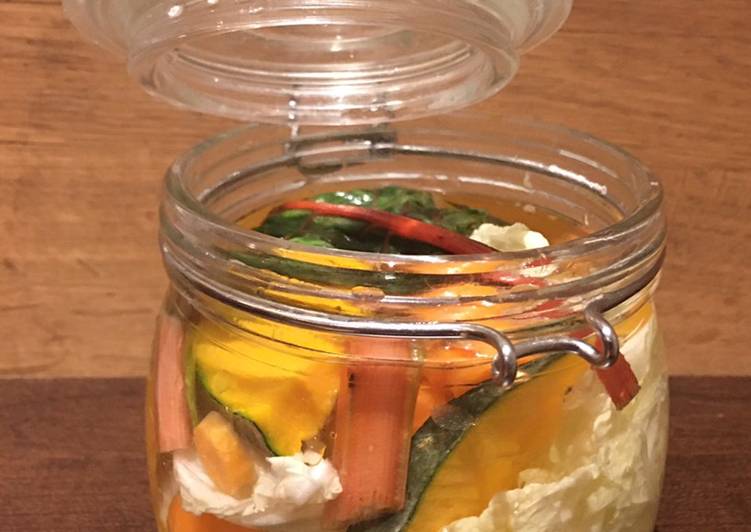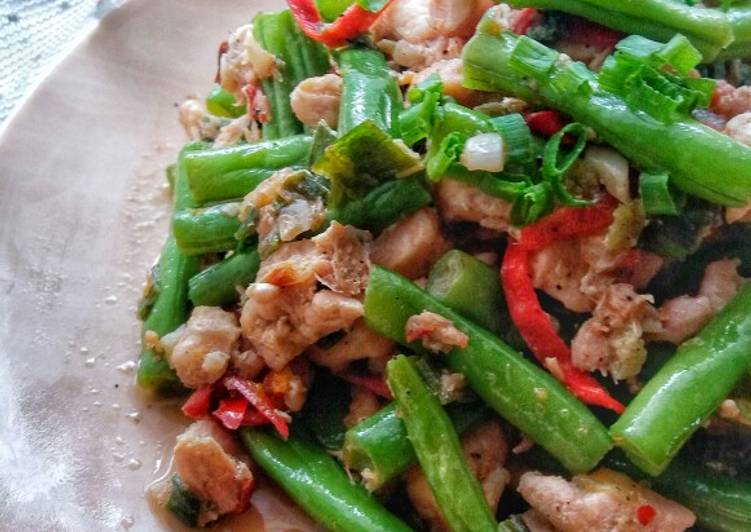
Hello everybody, it’s me again, Dan, welcome to my recipe site. Today, I will show you a way to prepare a special dish, fermented seasonal vegetables 🌱. It is one of my favorites food recipes. For mine, I’m gonna make it a little bit unique. This is gonna smell and look delicious.
Fermented seasonal Vegetables 🌱 is one of the most well liked of recent trending meals in the world. It is appreciated by millions every day. It is easy, it is quick, it tastes yummy. Fermented seasonal Vegetables 🌱 is something which I have loved my whole life. They are fine and they look wonderful.
Great recipe for Fermented seasonal Vegetables 🌱. Inspired by Cookpad's fermented project and a lot of amazingly delicious fermented foods I have eaten recently, this is a creation made from this weeks veg box. It has rainbow chard, cabbage, carrot, garlic and mustard seeds. Fermented vegetables begin with lacto-fermentation, a method of food preservation that also enhances the nutrient content of the food.
To get started with this particular recipe, we have to prepare a few components. You can have fermented seasonal vegetables 🌱 using 6 ingredients and 5 steps. Here is how you can achieve it.
The ingredients needed to make Fermented seasonal Vegetables 🌱:
- Get 1 clean jar
- Take Filtered water (I use a charcoal stick to filter)
- Prepare A selection of seasonal veg
- Prepare Seasalt flakes (see below)
- Get A selection of hard herbs and/or spices - I used mustard seeds in this one
- Prepare Ginger and/or garlic and/or chilli
The fermentation process is faster if you shred the vegetables finely. But if you're using a crock for a larger volume, keep the pieces larger and shred them after they're fermented. Follow a fermenting recipe for crock-size batches. Kimchi is an Asian version of fermented vegetables so if you like that, you'll definitely like these fermented vegetables.
Steps to make Fermented seasonal Vegetables 🌱:
- Clean the jar well. I used soapy water and popped it in the oven like you would when making pickles.
- Wash the veggies and chop to desired size.
- Using an electronic scale, place on your jar and return to zero. Fill the jar with your veg and spices. Using a jug of water, cover the veg to the top until they are fully submerged. Record weight total.
- Tip the water back into the jug. Do the maths to work our 2.5% of the recorded weight total. Add this quantity of salt to the water and stir until dissolved. Tip (now salty) water back until the jar until the veggies are submerged.
- You need to weight the veggies down so that they stay under the water. You can do this with a fermenting stone, a water bag or as I used a saucer with water poured on top. Secure the lid lightly without using the seal as it may explode. You can seal when it goes in the fridge. Leave to ferment for up to 7 days. Expect to see bubbles and life as you would sourdough. Store on a plate (see my sourdough 🤣)
Follow a fermenting recipe for crock-size batches. Kimchi is an Asian version of fermented vegetables so if you like that, you'll definitely like these fermented vegetables. Also make sure to try out this bulgogi kimchi rice plate and this kimchi potato hash. More pickled recipes to try if you love the taste of fermented vegetables: Spicy Pickled Pineapple Balsamic Pickled Shiitake Crostini Store your fermented vegetables in a cool place once they have reached a flavor that you like. The refrigerator or a root cellar are great options.
So that is going to wrap this up with this special food fermented seasonal vegetables 🌱 recipe. Thanks so much for reading. I’m confident you can make this at home. There is gonna be interesting food in home recipes coming up. Remember to save this page in your browser, and share it to your family, friends and colleague. Thanks again for reading. Go on get cooking!

